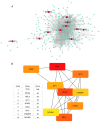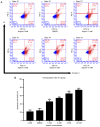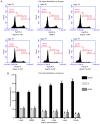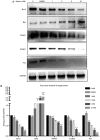Aspirin promotes apoptosis and inhibits proliferation by blocking G0/G1 into S phase in rheumatoid arthritis fibroblast-like synoviocytes via downregulation of JAK/STAT3 and NF-κB signaling pathway
- PMID: 30221683
- PMCID: PMC6202076
- DOI: 10.3892/ijmm.2018.3883
Aspirin promotes apoptosis and inhibits proliferation by blocking G0/G1 into S phase in rheumatoid arthritis fibroblast-like synoviocytes via downregulation of JAK/STAT3 and NF-κB signaling pathway
Abstract
Rheumatoid arthritis (RA) is a commonly occurring autoimmune disease. Its defining pathological characteristic is the excessive proliferation of fibroblast‑like synoviocytes (FLS), which is similar to tumor cells and results in a range of clinical problems. As a commonly used antipyretic, analgesic and anti‑inflammatory drug, aspirin is the first‑line treatment for RA. However, its mechanism of action has not been well explained. The goal is to investigate the biological effects of aspirin on primary RA‑FLS and its underlying mechanisms. In this experiment we treated cells with various concentrations of aspirin (0, DMSO, 1, 2, 5, 10 mM). Cell proliferation activity was detected with CCK‑8 assays. Apoptosis and cell cycle distribution were detected via flow cytometry. Apoptosis and cell cycle‑associated proteins (Bcl‑2, Bax, PRAP1, Cyclin D1, P21), as well as the key proteins and their phosphorylation levels of the NF‑κB and JAK/STAT3 signaling pathways, were detected via western blot analysis. Bioinformatics prediction revealed that aspirin was closely associated with cell proliferation and apoptosis, including the p53 and NF‑κB signaling pathways. By stimulating with aspirin, cell viability decreased, while the proportion of apoptotic cells increased, and the number of cells arrested in the G0/G1 phase increased in a dose‑dependent manner. The expression of Bax increased with aspirin stimulation, while the levels of Bcl‑2, PRAP1, Cyclin D1 and P21 decreased; p‑STAT3, p‑P65 and p‑50 levels also decreased while STAT3, P65, P50, p‑P105 and P105 remained unchanged. From our data, it can be concluded that aspirin is able to promote apoptosis and inhibit the proliferation of RA‑FLS through blocking the JAK/STAT3 and NF‑κB signaling pathways.
Figures








Similar articles
-
Matrine induces the apoptosis of fibroblast-like synoviocytes derived from rats with collagen-induced arthritis by suppressing the activation of the JAK/STAT signaling pathway.Int J Mol Med. 2017 Feb;39(2):307-316. doi: 10.3892/ijmm.2016.2843. Epub 2016 Dec 29. Int J Mol Med. 2017. PMID: 28035365 Free PMC article.
-
Ellipticine inhibits the proliferation and induces apoptosis in rheumatoid arthritis fibroblast-like synoviocytes via the STAT3 pathway.Immunopharmacol Immunotoxicol. 2017 Aug;39(4):219-224. doi: 10.1080/08923973.2017.1327963. Epub 2017 May 30. Immunopharmacol Immunotoxicol. 2017. PMID: 28555524
-
Piperlongumine inhibits the proliferation, migration and invasion of fibroblast-like synoviocytes from patients with rheumatoid arthritis.Inflamm Res. 2018 Mar;67(3):233-243. doi: 10.1007/s00011-017-1112-9. Epub 2017 Nov 8. Inflamm Res. 2018. PMID: 29119225
-
Apoptosis Induction of Fibroblast-Like Synoviocytes Is an Important Molecular-Mechanism for Herbal Medicine along with its Active Components in Treating Rheumatoid Arthritis.Biomolecules. 2019 Nov 28;9(12):795. doi: 10.3390/biom9120795. Biomolecules. 2019. PMID: 31795133 Free PMC article. Review.
-
Aspirin and the chemoprevention of cancers: A mathematical and evolutionary dynamics perspective.Wiley Interdiscip Rev Syst Biol Med. 2020 Sep;12(5):e1487. doi: 10.1002/wsbm.1487. Epub 2020 Mar 12. Wiley Interdiscip Rev Syst Biol Med. 2020. PMID: 32163237 Free PMC article. Review.
Cited by
-
Clinical Applications of Aspirin as a Multi-potent Drug Beyond Cardiovascular Implications: A Proof of Concept for Anesthesiologists- A Narrative Review.Anesth Pain Med. 2021 Oct 31;11(5):e118909. doi: 10.5812/aapm.118909. eCollection 2021 Oct. Anesth Pain Med. 2021. PMID: 35075415 Free PMC article. Review.
-
A Four-Pseudogene Classifier Identified by Machine Learning Serves as a Novel Prognostic Marker for Survival of Osteosarcoma.Genes (Basel). 2019 May 29;10(6):414. doi: 10.3390/genes10060414. Genes (Basel). 2019. PMID: 31146489 Free PMC article.
-
SPARC: a potential target for functional nanomaterials and drugs.Front Mol Biosci. 2023 Jul 28;10:1235428. doi: 10.3389/fmolb.2023.1235428. eCollection 2023. Front Mol Biosci. 2023. PMID: 37577749 Free PMC article. Review.
-
Natural Compound Mixture, Containing Emodin, Genipin, Chlorogenic Acid, Cimigenoside, and Ginsenoside Rb1, Ameliorates Psoriasis-Like Skin Lesions by Suppressing Inflammation and Proliferation in Keratinocytes.Evid Based Complement Alternat Med. 2020 Oct 22;2020:9416962. doi: 10.1155/2020/9416962. eCollection 2020. Evid Based Complement Alternat Med. 2020. PMID: 33149756 Free PMC article.
-
Shentong Zhuyu Decoction Inhibits Inflammatory Response, Migration, and Invasion and Promotes Apoptosis of Rheumatoid Arthritis Fibroblast-like Synoviocytes via the MAPK p38/PPARγ/CTGF Pathway.Biomed Res Int. 2021 Jan 15;2021:6187695. doi: 10.1155/2021/6187695. eCollection 2021. Biomed Res Int. 2021. PMID: 33511203 Free PMC article.
References
MeSH terms
Substances
LinkOut - more resources
Full Text Sources
Other Literature Sources
Research Materials
Miscellaneous

